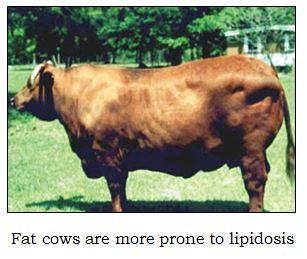
- Fatty liver can develop within 24 hours of an animal going off feed.
- This is typically happens around calving time. Fat mobilisation occurs as a result of negative energy balance which is exacerbated when off feed.
- The broken down fat is then converted back to fat in the liver thus the liver is filled with fat even when the cow is losing condition.
- Once fat is deposited in the liver, its concentration in the liver does not fall until the cow gets into positive energy balance, which can be over ten weeks after calving, particularly if the fatty liver is severe.
- Fat cows (Body Condition Score greater than 3.5) are much more prone to fatty liver. (Please see chapter on Body Condition Scoring)
- It is an important economic disease especially in high yielders because cows that develop fatty liver are affected by multiple metabolic and infectious diseases.
SYMPTOMS
- Lower milk yields
- Depressed appetite
- Incidences of milk fever, ketosis, mastitis, retained fetal membranes etc
- Reduced fertility
- This condition can be detected by blood tests.
- Mortality can be high.
PREVENTION
- There is no proven treatment for fatty liver.
- Ensuring that cows are calving at the correct body condition would prevent the breakdown of fat and fatty liver.
- An ideal body condition score to calve would be between 3 to 3.5 Cows should be dried of at this score and weight maintained through the dry period.
- Changing diets during this period should be avoided.
- Consult a veterinarian immediately if the above symptoms are seen.
- Glucose supplements can be given to overfat animals as preventive measure.
- Minimising stress is important for prevention of fatty liver. Sudden changes in environment should be avoided.
Overfeeding pregnant cattle may be risky
